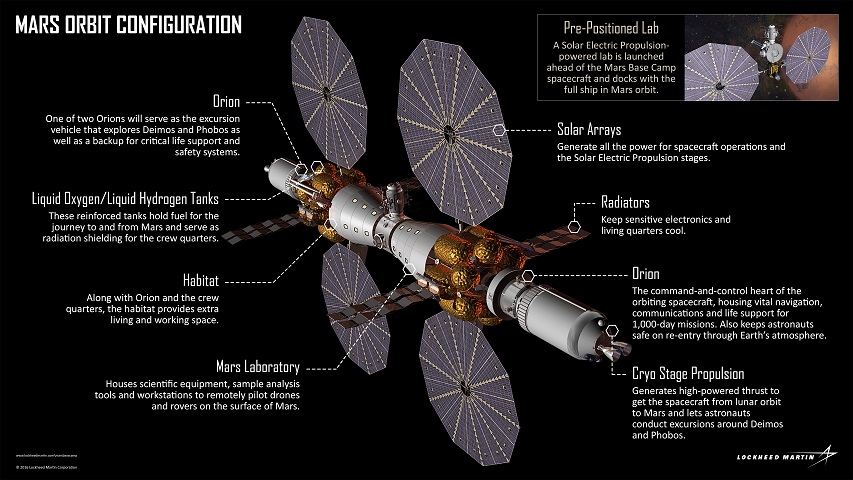


As NASA puts the finishing touches on the Space Launch System (SLS) and Orion capsule, partner Lockheed Martin is proposing an ambitious project that would make use of them. Tony Antonelli, a former NASA shuttle pilot and current head of advanced civil space programs for Lockheed Martin, says a manned Mars mission could happen as soon as 2028. The hypothetical project would be based on Lockheed’s Mars Base Camp design, which is capable of a three-year round-trip journey to Mars.
The Mars Base Camp would not look like your typical spacecraft with its symmetrical appearance. The craft would be based around a pair of Orion capsules and additional habitation and research space. The Orions would be docked at either end of the main structure. The central space could house as many as six astronauts for the duration of the three-year mission. The concept has a very “space station” vibe, but it’s not like we have many other interplanetary craft to compare it with.

While there would be two Orion capsules integrated with mars Base Camp, the mission would not include a human landing on the Red Planet. Orion isn’t designed to take off again once it has landed, and it relies on parachutes to land on Earth. Mars’ atmosphere is too thin for that type of landing. A completely different type of propulsive landing system would need to be developed. However, Mars Base Camp could be used to scout possible landing sites for a future manned landing.
Assembly of Mars Base Camp in orbit

Even if it won’t be landing, Mars Base Camp would be a huge step forward for manned spaceflight. Humans in orbit of Mars would be able to launch probes and robotic landers, and control them in real time. That’s vastly more efficient than launching each probe individually and controlling it from millions of miles away. There are also experiments that can be performed at Mars orbit by astronauts. One of the attached Orion capsules could also be used to fly missions to one of Mars’ two moons, Phobos and Deimos. A human landing there might be possible thanks to the extremely low gravity.
If the Mars Base Camp idea goes forward, it would require the cooperation of NASA and several private space firms in addition to Lockheed. The concept calls for construction of the deployment of an assembly platform in cis-lunar orbit during 2021. Supplies would be sent to Mars ahead of time around 2026, and the mission could launch in 2028. Antonelli claims all the technology we need would be available within the next decade. It’s all possible, but this timeline assumes there are no delays with Orion or the SLS.

Source: Extreme Tech
